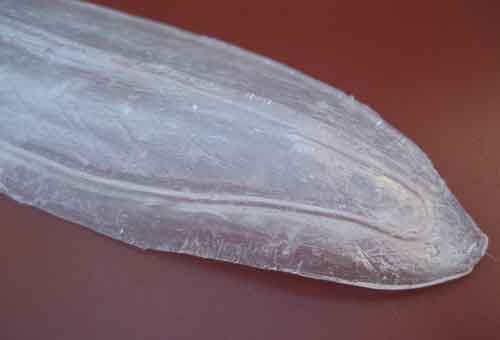 |
de | fr | en Druckansicht ![]()
An new training device for taking blood and administering substances intravenously in rabbits (artificial rabbit ear)
Oktober 2011Author: Narcisse Pascal Martin, Lachenweg 22, 4125 Riehen, Switzerland
E-mail: Info@n-p-m.ch
https://www.n-p-m.ch
The rabbit silicone ear is a new patented training device for practising taking blood and carrying out intravenous injections in rabbit ear veins and arteries. It replaces the need for using live animals in the initial basic exercises required for trainees in animal experimental techniques.
Keywords: rabbit; blood sampling; replacement; blood sampling; intravenous injection; training device
Method
In rabbits, blood samples are often taken and substances injected via veins and arteries in the ear. Accordingly trainees in animal experimentation methods have to be introduced to this practice in initial courses (obligatory in Switzerland before carrying out animal experiments). This training is normally carried out using live animals and causes stress and even pain mainly owing to the inexperience and nervousness of the trainees. Often the rabbits develop ear swellings and hematoma.
The present silicon ear (Fig.1) is a training device to allow students to practise blood sampling (movie 1) and carrying out intravenous injections (movie 2) and replaces or at least reduces the number of live animals that need to be used, as well as reducing nervousness among the trainees. The hand-made silicone replica corresponds to the natural rabbit ear in shape and size. Cast-in tubes simulate the blood vessels, which behave authentically when a needle is inserted and blood is withdrawn. In addition blood flow and pressure can be simulated and controlled manually via the connected syringes. The holes left after injections can be refilled and repaired many times.
The device allows initial, realistic hands-on training. The trainee gains confidence and precision for subsequent work with syringes on live animals. Many manipulations can be practised such as the position for inserting the needle into the ear vein, holding the needle by the left thumb and withdrawing blood, applying a cotton-wool ball at the injection site before withdrawing the needle or the use of clips on top of the cotton-wool ball for 2-3 minutes to stop further bleeding.
In 2010, the silicone ear was awarded a prize by the Swiss Laboratory Animal Science Association (1) and has been used since in a number of training courses for laboratory animal science in Switzerland (2,3). The training device has been much appreciated by the trainees.
3R effect
This silicon ear, intended for use as a training device for students to practise blood sampling and intravenous injection in rabbit ear veins and arteries, replaces the need for using live animals in the initial basic exercises required for trainees in animal experimental techniques. The rabbits used in standard training exercises often experience stress and pain and in some cases swelling and hematoma can be observed in the ear.
References/ Links
1. The silicon model ear was awarded a prize by the Swiss Laboratory Animal Science Association in 2010 http://www.sgv.org/de/about/SGV_award.html
2. User: University of Zurich, Institute for Laboratory Animal Science, Dr. Philippe Bugnon - http://www.ltk.unizh.ch/de
3. User: University of Lausanne - RESAL (Lake Geneva Animal Laboratory Network), Dr. Isabelle Desbaillets -http://www.unil.ch/resal/page41822_en.html
4. Detailed information (in German, English and French), photos and film for practical application available on the author’s hompage at www.n-p-m.ch/english/application/
Figures
Movie 1
Blood sampling from rabbit ear artery
Movie 2
Intravenous injection into the rabbit vein

Figure 1
| Letzte Änderung: 19.03.2018 |